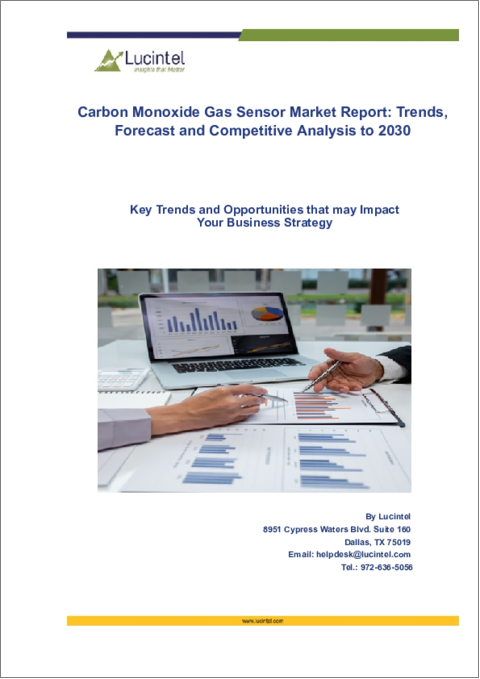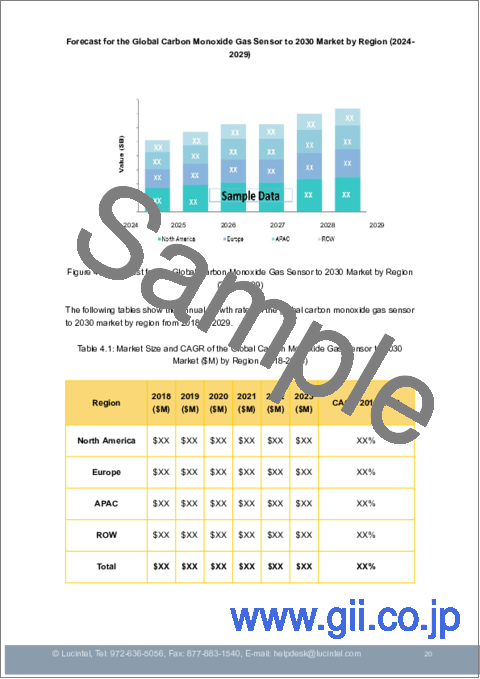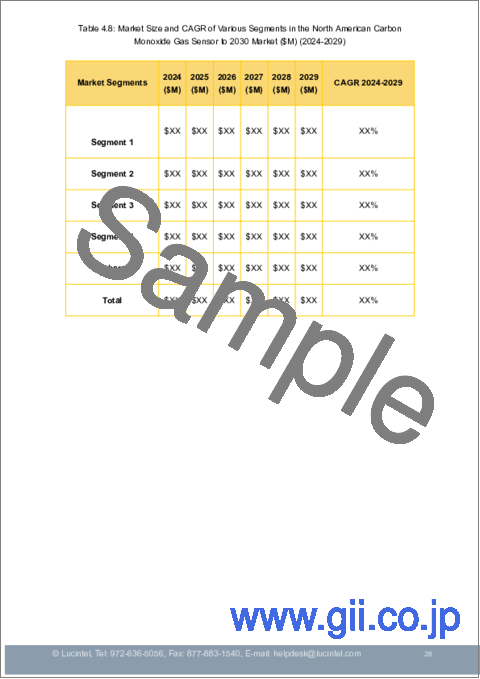|
|
市場調査レポート
商品コード
1523090
一酸化炭素ガスセンサー市場レポート:2030年までの動向、予測、競合分析Carbon Monoxide Gas Sensor Market Report: Trends, Forecast and Competitive Analysis to 2030 |
||||||
カスタマイズ可能
適宜更新あり
|
|||||||
| 一酸化炭素ガスセンサー市場レポート:2030年までの動向、予測、競合分析 |
|
出版日: 2024年07月01日
発行: Lucintel
ページ情報: 英文 150 Pages
納期: 3営業日
|
全表示
- 概要
- 目次
一酸化炭素ガスセンサーの動向と予測
世界の一酸化炭素ガスセンサー市場は、2024年から2030年にかけてCAGR 5.7%で成長すると予測されています。この市場の主な促進要因は、安全・セキュリティ用途でのCOガスセンサー需要の増加、環境意識の高まり、世界各国の政府が特定の用途でCOガスセンサーの使用を義務付ける規制を実施していることです。世界の一酸化炭素ガスセンサー市場の将来は、医療、石油化学、ビルオートメーション、産業、環境、自動車市場での機会で有望視されています。
セグメント別一酸化炭素ガスセンサー
この調査には、世界の一酸化炭素ガスセンサーの技術別、用途別、地域別の予測が含まれています。
一酸化炭素ガスセンサー市場の洞察
Lucintelの予測では、電気化学センサーは、優れた精度、迅速な応答時間、高感度により、予測期間中に最も高い成長を示すことが予想され、センサーは家庭用と商業用の両方の用途に適しており、低濃度のCOガスを識別することができます。
この市場の中では、自動車が最大のセグメントであり続けると思われます。
北米は、政府規制の強化、安全への懸念、センサー技術の発展により、予測期間中も最大地域であり続けると思われます。
よくある質問
Q1.市場の成長予測は:
A1.世界の一酸化炭素ガスセンサー市場は、2024年から2030年にかけてCAGR 5.7%で成長する見込みです。
Q2.市場の成長に影響を与える主な促進要因は:
A2.この市場の主な促進要因は、安全・セキュリティ用途でのCOガスセンサー需要の増加、環境意識の高まり、世界各国の政府が特定の用途でCOガスセンサーの使用を義務付ける規制を実施していることです。
Q3.市場の主要セグメントは:
A3.一酸化炭素ガスセンサー市場の将来は、医療、石油化学、ビルオートメーション、産業、環境、自動車市場において有望です。
Q4.市場の主要企業は:
A4.主な一酸化炭素ガスセンサー企業は以下の通りです:
- Aeroqual
- Robert Bosch
- Siemens
- Yokogawa Electric
- ABB
- GfG Europe
- Alphasense
- Dynament
- NGK Insulators
- Trolex
Q5.今後、最大となる市場セグメントは:
A5.Lucintelは、電気化学センサーは、優れた精度、迅速な応答時間、高感度により、予測期間中に最も高い成長を示すことが期待され、センサーは家庭用と商業用の両方の用途に適しており、低濃度のCOガスを識別することができると予測しています。
Q6.市場において、今後5年間に最大になると予想される地域は:
A6.北米は、政府規制の強化、安全性への懸念、同地域でのセンサー技術開発により、予測期間中も最大地域であり続けます。
Q7.レポートのカスタマイズは可能か:
A7.はい、Lucintelは追加費用なしで10%のカスタマイズを提供します。
目次
第1章 エグゼクティブサマリー
第2章 世界の一酸化炭素ガスセンサー市場:市場力学
- イントロダクション、背景、分類
- サプライチェーン
- 業界の促進要因と課題
第3章 2018年から2030年までの市場動向と予測分析
- マクロ経済動向(2018~2023年)と予測(2024~2030年)
- 世界の一酸化炭素ガスセンサー市場の動向(2018~2023年)と予測(2024~2030年)
- 技術別世界の一酸化炭素ガスセンサー市場
- 半導体センサー
- 電気化学センサー
- ソリッドステート/MOSセンサー
- ピジョン
- 触媒
- 赤外線
- 用途別世界の一酸化炭素ガスセンサー市場
- 医療
- 石油化学
- ビルオートメーション
- 産業
- 環境
- 自動車
- その他
第4章 2018年から2030年までの地域別市場動向と予測分析
- 地域別の世界の一酸化炭素ガスセンサー市場
- 北米の一酸化炭素ガスセンサー市場
- 欧州の一酸化炭素ガスセンサー市場
- アジア太平洋の一酸化炭素ガスセンサー市場
- その他地域の一酸化炭素ガスセンサー市場
第5章 競合分析
- 製品ポートフォリオ分析
- 運用統合
- ポーターのファイブフォース分析
第6章 成長機会と戦略分析
- 成長機会分析
- 技術別世界の一酸化炭素ガスセンサー市場の成長機会
- 用途別世界一酸化炭素ガスセンサー市場の成長機会
- 地域別の世界の一酸化炭素ガスセンサー市場の成長機会
- 世界の一酸化炭素ガスセンサー市場の新たな動向
- 戦略分析
- 新製品の開発
- 世界の一酸化炭素ガスセンサー市場の生産能力拡大
- 世界の一酸化炭素ガスセンサー市場における合併、買収、合弁事業
- 認証とライセンシング
第7章 主要企業の企業プロファイル
- Aeroqual
- Robert Bosch
- Siemens
- Yokogawa Electric
- ABB
- GfG Europe
- Alphasense
- Dynament
- NGK Insulators
- Trolex
Carbon Monoxide Gas Sensor Trends and Forecast
The future of the global carbon monoxide gas sensor market looks promising with opportunities in the medical, petrochemical, building automation, industrial, environmental, and automotive markets. The global carbon monoxide gas sensor market is expected to grow with a CAGR of 5.7% from 2024 to 2030. The major drivers for this market are increasing demand for CO gas sensors in safety and security applications, rising environmental awareness, and governments around the world are implementing regulations that require the use of CO gas sensors in certain applications.
A more than 150-page report is developed to help in your business decisions. Sample figures with some insights are shown below.
Carbon Monoxide Gas Sensor by Segment
The study includes a forecast for the global carbon monoxide gas sensor by technology, application, and region.
Carbon Monoxide Gas Sensor Market by Technology [Shipment Analysis by Value from 2018 to 2030]:
- Semiconductor Sensor
- Electrochemical Sensor
- Solid State/MOS Sensor
- PID
- Catalytic
- Infrared
Carbon Monoxide Gas Sensor Market by Application [Shipment Analysis by Value from 2018 to 2030]:
- Medical
- Petrochemical
- Building Automation
- Industrial
- Environmental
- Automotive
- Others
Carbon Monoxide Gas Sensor Market by Region [Shipment Analysis by Value from 2018 to 2030]:
- North America
- Europe
- Asia Pacific
- The Rest of the World
List of Carbon Monoxide Gas Sensor Companies
Companies in the market compete on the basis of product quality offered. Major players in this market focus on expanding their manufacturing facilities, R&D investments, infrastructural development, and leverage integration opportunities across the value chain. With these strategies carbon monoxide gas sensor companies cater increasing demand, ensure competitive effectiveness, develop innovative products & technologies, reduce production costs, and expand their customer base. Some of the carbon monoxide gas sensor companies profiled in this report include-
- Aeroqual
- Robert Bosch
- Siemens
- Yokogawa Electric
- ABB
- GfG Europe
- Alphasense
- Dynament
- NGK Insulators
- Trolex
Carbon Monoxide Gas Sensor Market Insights
Lucintel forecasts that electrochemical sensors is expected to witness the highest growth over the forecast period due to excellent accuracy, quick response time, and high sensitivity, and the sensors are appropriate for both home and commercial applications and can identify low concentrations of CO gas.
Within this market, automotive will remain the largest segment.
North America will remain the largest region over the forecast period due to growing governmental rules, safety concerns, and sensor technology developments in the region.
Features of the Global Carbon Monoxide Gas Sensor Market
Market Size Estimates: Carbon monoxide gas sensor market size estimation in terms of value ($B).
Trend and Forecast Analysis: Market trends (2018 to 2023) and forecast (2024 to 2030) by various segments and regions.
Segmentation Analysis: Carbon monoxide gas sensor market size by technology, application, and region in terms of value ($B).
Regional Analysis: Carbon monoxide gas sensor market breakdown by North America, Europe, Asia Pacific, and Rest of the World.
Growth Opportunities: Analysis of growth opportunities in different technology, application, and regions for the carbon monoxide gas sensor market.
Strategic Analysis: This includes M&A, new product development, and competitive landscape of the carbon monoxide gas sensor market.
Analysis of competitive intensity of the industry based on Porter's Five Forces model.
FAQ
Q1. What is the growth forecast for carbon monoxide gas sensor market?
Answer: The global carbon monoxide gas sensor market is expected to grow with a CAGR of 5.7% from 2024 to 2030.
Q2. What are the major drivers influencing the growth of the carbon monoxide gas sensor market?
Answer: The major drivers for this market are increasing demand for CO gas sensors in safety and security applications, rising environmental awareness, and governments around the world are implementing regulations that require the use of CO gas sensors in certain applications.
Q3. What are the major segments for carbon monoxide gas sensor market?
Answer: The future of the carbon monoxide gas sensor market looks promising with opportunities in the medical, petrochemical, building automation, industrial, environmental, and automotive markets.
Q4. Who are the key carbon monoxide gas sensor market companies?
Answer: Some of the key carbon monoxide gas sensor companies are as follows:
- Aeroqual
- Robert Bosch
- Siemens
- Yokogawa Electric
- ABB
- GfG Europe
- Alphasense
- Dynament
- NGK Insulators
- Trolex
Q5. Which carbon monoxide gas sensor market segment will be the largest in future?
Answer: Lucintel forecasts that electrochemical sensors is expected to witness the highest growth over the forecast period due to excellent accuracy, quick response time, and high sensitivity, and the sensors are appropriate for both home and commercial applications and can identify low concentrations of CO gas.
Q6. In carbon monoxide gas sensor market, which region is expected to be the largest in next 5 years?
Answer: North America will remain the largest region over the forecast period due to growing governmental rules, safety concerns, and sensor technology developments in the region.
Q7. Do we receive customization in this report?
Answer: Yes, Lucintel provides 10% customization without any additional cost.
This report answers following 11 key questions:
- Q.1. What are some of the most promising, high-growth opportunities for the carbon monoxide gas sensor market by technology (semiconductor sensor, electrochemical sensor, solid state/MOS sensor, PID, catalytic, and infrared), application (medical, petrochemical, building automation, industrial, environmental, automotive , and others), and region (North America, Europe, Asia Pacific, and the Rest of the World)?
- Q.2. Which segments will grow at a faster pace and why?
- Q.3. Which region will grow at a faster pace and why?
- Q.4. What are the key factors affecting market dynamics? What are the key challenges and business risks in this market?
- Q.5. What are the business risks and competitive threats in this market?
- Q.6. What are the emerging trends in this market and the reasons behind them?
- Q.7. What are some of the changing demands of customers in the market?
- Q.8. What are the new developments in the market? Which companies are leading these developments?
- Q.9. Who are the major players in this market? What strategic initiatives are key players pursuing for business growth?
- Q.10. What are some of the competing products in this market and how big of a threat do they pose for loss of market share by material or product substitution?
- Q.11. What M&A activity has occurred in the last 5 years and what has its impact been on the industry?
Table of Contents
1. Executive Summary
2. Global Carbon Monoxide Gas Sensor Market : Market Dynamics
- 2.1: Introduction, Background, and Classifications
- 2.2: Supply Chain
- 2.3: Industry Drivers and Challenges
3. Market Trends and Forecast Analysis from 2018 to 2030
- 3.1. Macroeconomic Trends (2018-2023) and Forecast (2024-2030)
- 3.2. Global Carbon Monoxide Gas Sensor Market Trends (2018-2023) and Forecast (2024-2030)
- 3.3: Global Carbon Monoxide Gas Sensor Market by Technology
- 3.3.1: Semiconductor Sensor
- 3.3.2: Electrochemical Sensor
- 3.3.3: Solid State/MOS Sensor
- 3.3.4: PID
- 3.3.5: Catalytic
- 3.3.6: Infrared
- 3.4: Global Carbon Monoxide Gas Sensor Market by Application
- 3.4.1: Medical
- 3.4.2: Petrochemical
- 3.4.3: Building Automation
- 3.4.4: Industrial
- 3.4.5: Environmental
- 3.4.6: Automotive
- 3.4.7: Others
4. Market Trends and Forecast Analysis by Region from 2018 to 2030
- 4.1: Global Carbon Monoxide Gas Sensor Market by Region
- 4.2: North American Carbon Monoxide Gas Sensor Market
- 4.2.1: North American Carbon Monoxide Gas Sensor Market by Technology: Semiconductor Sensor, Electrochemical Sensor, Solid State/MOS Sensor, PID, Catalytic, and Infrared
- 4.2.2: North American Carbon Monoxide Gas Sensor Market by Application: Medical, Petrochemical, Building Automation, Industrial, Environmental, Automotive, and Others
- 4.3: European Carbon Monoxide Gas Sensor Market
- 4.3.1: European Carbon Monoxide Gas Sensor Market by Technology: Semiconductor Sensor, Electrochemical Sensor, Solid State/MOS Sensor, PID, Catalytic, and Infrared
- 4.3.2: European Carbon Monoxide Gas Sensor Market by Application: Medical, Petrochemical, Building Automation, Industrial, Environmental, Automotive, and Others
- 4.4: APAC Carbon Monoxide Gas Sensor Market
- 4.4.1: APAC Carbon Monoxide Gas Sensor Market by Technology: Semiconductor Sensor, Electrochemical Sensor, Solid State/MOS Sensor, PID, Catalytic, and Infrared
- 4.4.2: APAC Carbon Monoxide Gas Sensor Market by Application: Medical, Petrochemical, Building Automation, Industrial, Environmental, Automotive, and Others
- 4.5: ROW Carbon Monoxide Gas Sensor Market
- 4.5.1: ROW Carbon Monoxide Gas Sensor Market by Technology: Semiconductor Sensor, Electrochemical Sensor, Solid State/MOS Sensor, PID, Catalytic, and Infrared
- 4.5.2: ROW Carbon Monoxide Gas Sensor Market by Application: Medical, Petrochemical, Building Automation, Industrial, Environmental, Automotive, and Others
5. Competitor Analysis
- 5.1: Product Portfolio Analysis
- 5.2: Operational Integration
- 5.3: Porter's Five Forces Analysis
6. Growth Opportunities and Strategic Analysis
- 6.1: Growth Opportunity Analysis
- 6.1.1: Growth Opportunities for the Global Carbon Monoxide Gas Sensor Market by Technology
- 6.1.2: Growth Opportunities for the Global Carbon Monoxide Gas Sensor Market by Application
- 6.1.3: Growth Opportunities for the Global Carbon Monoxide Gas Sensor Market by Region
- 6.2: Emerging Trends in the Global Carbon Monoxide Gas Sensor Market
- 6.3: Strategic Analysis
- 6.3.1: New Product Development
- 6.3.2: Capacity Expansion of the Global Carbon Monoxide Gas Sensor Market
- 6.3.3: Mergers, Acquisitions, and Joint Ventures in the Global Carbon Monoxide Gas Sensor Market
- 6.3.4: Certification and Licensing
7. Company Profiles of Leading Players
- 7.1: Aeroqual
- 7.2: Robert Bosch
- 7.3: Siemens
- 7.4: Yokogawa Electric
- 7.5: ABB
- 7.6: GfG Europe
- 7.7: Alphasense
- 7.8: Dynament
- 7.9: NGK Insulators
- 7.10: Trolex





